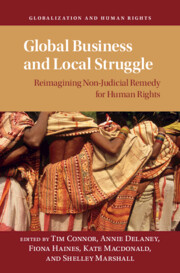Book contents
- Global Business and Local Struggle
- Globalization and Human Rights
- Global Business and Local Struggle
- Copyright page
- Dedication
- Contents
- Figures
- Tables
- Preface
- Acknowledgements
- Abbreviations
- Introduction: Inflated Promises and Small Victories
- 1 Two Countries, Three Industries, Ten Stories
- 2 The Promise of Effective NJM Design
- 3 NJM Design and Human Rights Redress in Practice
- 4 NJMs as Interventions in Fields of Struggle
- 5 NJMs as Community Leverage against Business Power
- 6 NJMs and the Conflicting Roles of the State
- 7 Key Findings
- 8 Towards More Responsive Redress?
- References
- Index
- Series page
Introduction: Inflated Promises and Small Victories
Published online by Cambridge University Press: 18 July 2025
- Global Business and Local Struggle
- Globalization and Human Rights
- Global Business and Local Struggle
- Copyright page
- Dedication
- Contents
- Figures
- Tables
- Preface
- Acknowledgements
- Abbreviations
- Introduction: Inflated Promises and Small Victories
- 1 Two Countries, Three Industries, Ten Stories
- 2 The Promise of Effective NJM Design
- 3 NJM Design and Human Rights Redress in Practice
- 4 NJMs as Interventions in Fields of Struggle
- 5 NJMs as Community Leverage against Business Power
- 6 NJMs and the Conflicting Roles of the State
- 7 Key Findings
- 8 Towards More Responsive Redress?
- References
- Index
- Series page
Summary
Are non-judicial approaches to remedying business-related human rights violations a good use of the resources invested in them, or a counterproductive distraction from alternative legal or activist pathways to remedy? This chapter outlines the book’s approach to exploring this divisive question, drawing on field-work intensive case studies of human rights grievances across three industrial sectors in Indonesia and India. This introductory chapter launches the book’s argument that while NJMs are seriously limited in their ability to deliver adequate human rights redress, NJMs can nonetheless make small but useful contributions to broader struggles for human rights remedy, never by substituting for binding state-led regulatory and redress processes, but rather by providing entry points through which workers and communities can sometimes mobilise additional resources or sources of leverage in support of their struggles for redress. These findings imply the need for a responsive approach to NJM institutional design and regulatory strategy, in which NJMs are mobilised more explicitly as part of a wider field of struggle to counterbalance some of the entrenched inequalities that buttress recurring patterns of human rights grievances around the world.
Keywords
Information
- Type
- Chapter
- Information
- Global Business and Local StruggleReimagining Non-Judicial Remedy for Human Rights, pp. 1 - 15Publisher: Cambridge University PressPrint publication year: 2025
